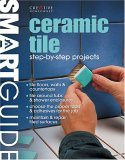Installing Ceramic Tile over Linoleum Fastened to a Concrete Slab Can be Problematic
By Mark J. Donovan
|
|
Question: Hi Mark, I have a question regarding my bathroom which sits on a basement concrete slab. I want to ceramic tile my basement bathroom floor. I have already purchased plenty of ceramic tile and have laid most of it out on the bathroom floor to find a pattern I liked.
My main concern is that the bathroom floor already has linoleum on it. It is in great shape but is simply outdated. I want to know if I can install the ceramic tile directly on top of the linoleum or should I remove the linoleum. |
When the tile is down it doesn’t interfere with the swing of the door. As I’ve already mentioned it’s a basement floor and so I believe there is concrete directly underneath the linoleum.
There could possibly be a wood subfloor between the concrete basement floor and the linoleum but I don’t think so. So my question to you is can I tile over the linoleum with maybe a vapor barrier, or should I remove the linoleum first? M.T.
Answer: M.T., First, it should be fairly easy to assess if there is a subfloor underneath the linoleum. When you walk or bang the floor you will hear a slightly hollow sound if there is a subfloor over the concrete slab. I’d be a little surprised if there was one.
| Now, to answer your question on tiling over linoleum installed on a basement concrete slab. I’ve installed ceramic tile over bathroom linoleum in the past that was attached solidly to a wood subfloor.
However, before installing the ceramic tile I applied wood screws on 6 inch centers over the entire linoleum surface just to ensure a solid surface for installing the tiles. I’ve never had a problem with the ceramic tile lifting, even after 10 years. |
 |
This said, other times when I’ve contemplated tiling directly over linoleum surfaces I discovered that the linoleum was peeling at the edges and/or had a cushioned vinyl surface.
I also noticed that when I sank screws into the linoleum that it actually lifted up the linoleum on the screws as they penetrated into the wood subfloor. Consequently I abandoned those attempts to install ceramic tile over linoleum and removed the linoleum first.
So without being able to ensure that the linoleum won’t lift, for example installing screws over the surface of it, my recommendation would be to remove the old linoleum, assuming it was installed after 1978.
Linoleum installed prior to 1978 could have asbestos in it, so you certainly don’t want to be personally disturbing it in this case. Call an asbestos abatement contractor to remove it if you suspect the linoleum installation pre-dates 1978. Alternatively, if you do believe the linoleum is pre-1978 and you don’t want to deal with the expense of having an asbestos abatement contractor remove it, and your are sure it is fastened well to the concrete slab, then yes you may just want to ceramic tile directly over the linoleum. But it comes with risk, loosening tiles and/or crumbling grout.
| To remove linoleum from a subfloor or concrete slab your best bet is to use a long handle 6 inch wide ice scraper to lift up the linoleum. It normally comes off fairly easy.
After removing the bulk of it, you may need to use a sharp 3 inch tapered blade to remove any residual material. Alternatively you can rent a power vinyl stripper from your local home improvement center. |
 |
Once the linoleum has been sufficiently removed, and the area swept and vacuumed clean, you can then inspect the basement concrete slab for any cracks or water issues.
It’s important to make sure there is no underlying moisture problem with the concrete slab. Otherwise the thinset mortar could break down and deteriorate over time. The result will be loose tiles and cracking grout lines.
With most concrete slab tile installations today, an uncoupling membrane is usually installed between the concrete slab and the ceramic tile. The uncoupling membrane, as the name suggests, decouples the transfer of concrete slab movement (e.g. future slab cracks/settling) with the tile surface. Thinset mortar can be applied directly over the uncoupling membrane and the tiles set in the mortar. Schluter makes an uncoupling underlayment called Ditra that is meant specifically for tiling over a concrete slab.
After repairing the cement floor cracks and installing the uncoupling membrane you can finally begin the actual task of ceramic tiling your bathroom floor.
For information on installing a shower pan membrane liner for a ceramic tile shower, see the Shower Pan Membrane Liner Installation Ebook from HomeAdditionPlus.com. The Shower Pan Membrane Liner EBook will quickly teach you the step-by-step process for installing the shower pan membrane liner correctly. It includes instructions on framing the shower stall, pouring the pre-slope and shower base mortar, and installing the shower pan membrane liner.
See HomeAdditionPlus.com’s Ceramic Tile Calculator
See my “How to Tile a Custom Ceramic Tile Shower” Ebook to learn how to tile your own shower: For a detailed set of instructions on tiling a shower floor and walls, including pictures for every step in the process, see my “How to Tile Custom Ceramic Tile Shower Ebook”.
Related Information
- How to Install Tile over Linoleum Floor
- Tiling over a Vinyl Floor
- Uncoupling Membranes for Tiling over a Cement Slab
Additional Ceramic Tile Resources from Amazon.com
 |
 |
 |
Get Free Bathroom Remodeling Price Quotes with No Obligation!
Fill out our 3-5 minute quick and easy form, and receive a free price quote on a bathroom remodeling project from one of our pre-screened and licensed bathroom remodeling contractors. This process is free and there is no obligation to continue once you receive your bathroom addition price estimate.
